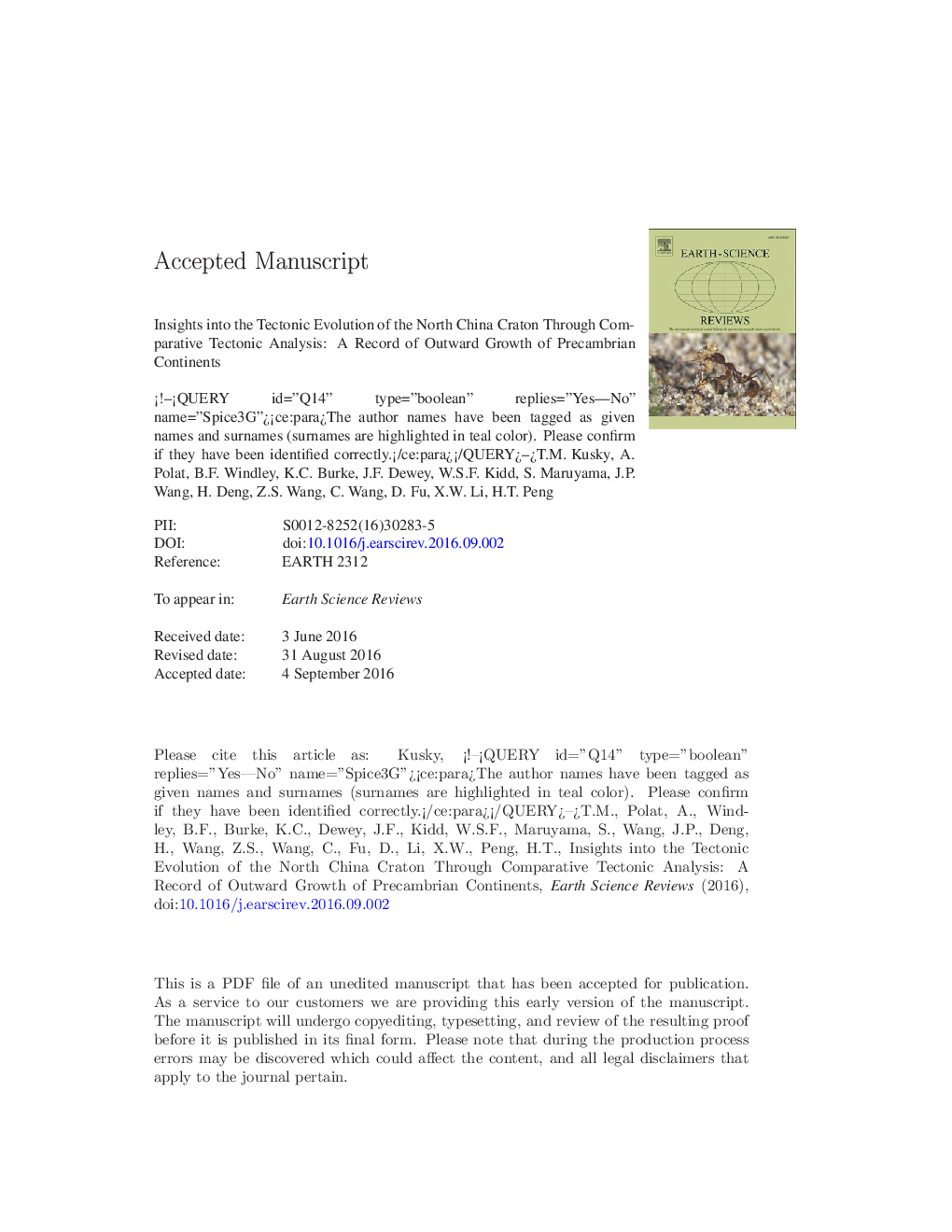| کد مقاله | کد نشریه | سال انتشار | مقاله انگلیسی | نسخه تمام متن |
|---|---|---|---|---|
| 6442779 | 1639940 | 2016 | 183 صفحه PDF | دانلود رایگان |
عنوان انگلیسی مقاله ISI
Insights into the tectonic evolution of the North China Craton through comparative tectonic analysis: A record of outward growth of Precambrian continents
دانلود مقاله + سفارش ترجمه
دانلود مقاله ISI انگلیسی
رایگان برای ایرانیان
کلمات کلیدی
موضوعات مرتبط
مهندسی و علوم پایه
علوم زمین و سیارات
زمین شناسی
پیش نمایش صفحه اول مقاله

چکیده انگلیسی
Andean margin tectonics affected much of the continental block from 2.3 to 1.9Â Ga, giving rise to a broad E-W swath of continental margin magmas, and retro-arc sedimentary basins including a foreland basin superimposed on the passive northern margin. The horizontal extent of these tectonic components is similar to that across the present-day Andes in South America. From 1.88 to 1.79Â Ga a granulite facies metamorphic event was superimposed across the entire continental block with high-pressure granulites and eclogites in the north, and medium-pressure granulites across the whole craton to the south. The scale and duration of this post-collisional event is similar to that in Central Asia that resulted from the Cenozoic India-Asia collision. The deep crustal granulites and volcanic rocks on the surface today, interpreted to be anatectic melts from deep crustal granulites, are similar to high-grade metamorphic rocks and partial melts presently forming at mid-crustal levels beneath Tibet. Structural fabrics in lower-crustal migmatites related to this event reveal that they flowed laterally parallel to the collision boundary, in a way comparable to what is speculated to be happening in the deep crust of the Himalayan/Tibetan foreland. We relate this continent-continent collision to the collision of the North China Craton with the postulated Columbia (Nuna) Continent. The NCC broke out of the Columbia Continent between 1753-1673Â Ma, as shown by the formation of a suite of anorthosite, mangerite, charnockite, and alkali-feldspar granites in an ENE-striking belt along the northern margin of the craton, whose intrusion was followed by the development of rifts and graben, mafic dike swarms, and eventually an Atlantic-type passive margin that signaled the beginning of a long period of tectonic quiescence and carbonate deposition for the NCC during Sinian times, which persisted into the Paleozoic. The style of tectonic accretion in the NCC changed at circa 2.5Â Ga, from an earlier phase of accretion of arcs that are presently preserved in horizontal lengths of several hundred kilometers, to the accretion and preservation of linear arcs several thousand kilometers long with associated oceanic plateaus, microcontinents, and accretionary prisms. The style of progressively younger and westward outward accretion of different tectonic components is reminiscent of the style of accretion in the Superior Craton, and may signal the formation of progressively larger landmasses at the end of the Archean (perhaps like the Kenorland Continent), then into the Paleoproterozoic, culminating in the assembly of the Columbia (Nuna) Continent at 1.9-1.8Â Ga.
ناشر
Database: Elsevier - ScienceDirect (ساینس دایرکت)
Journal: Earth-Science Reviews - Volume 162, November 2016, Pages 387-432
Journal: Earth-Science Reviews - Volume 162, November 2016, Pages 387-432
نویسندگان
T.M. Kusky, A. Polat, B.F. Windley, K.C. Burke, J.F. Dewey, W.S.F. Kidd, S. Maruyama, J.P. Wang, H. Deng, Z.S. Wang, C. Wang, D. Fu, X.W. Li, H.T. Peng,